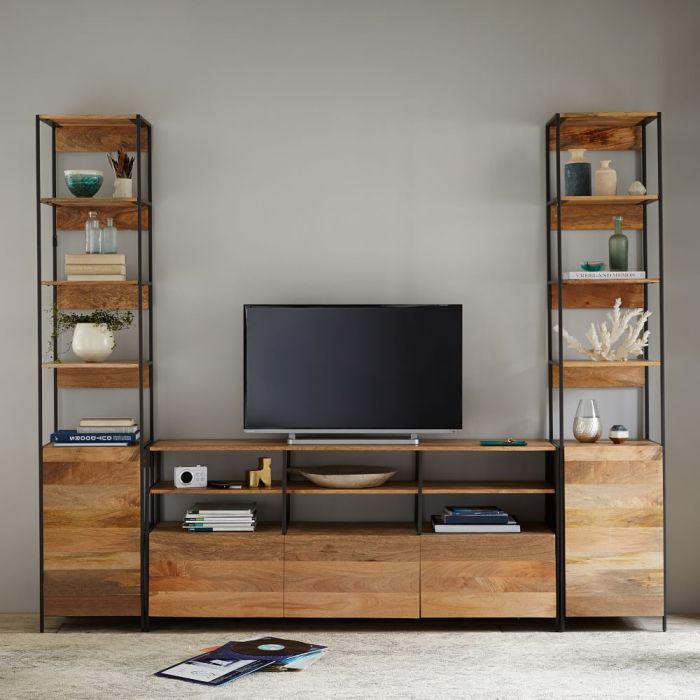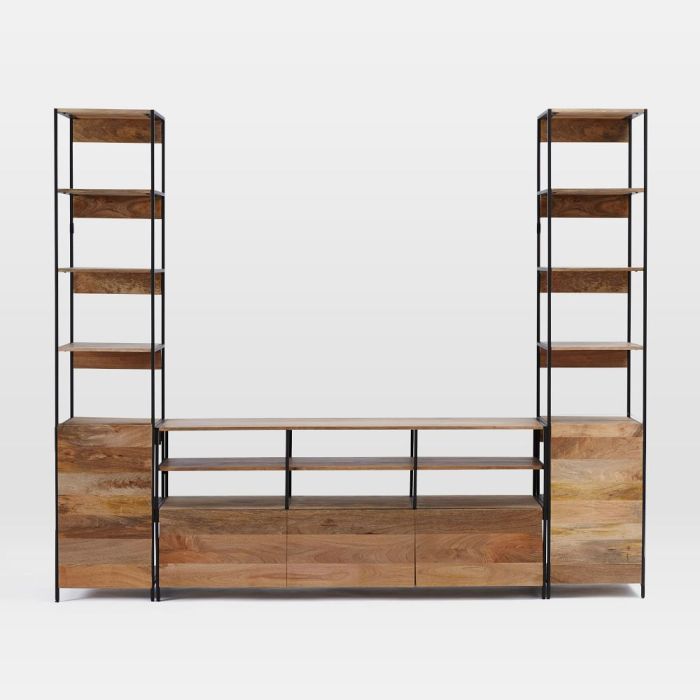Multi-use media center furniture with open storage offers a compelling blend of functionality and style. These versatile pieces seamlessly integrate entertainment systems, storage solutions, and aesthetic appeal into a single, cohesive unit. The open storage design promotes easy access to frequently used items, while the media center functionality streamlines entertainment experiences. This adaptable furniture caters to diverse lifestyles and space constraints, making it a practical and stylish addition to any home.
Consider the impact of open shelving on the overall aesthetic. Does it complement a minimalist design or add a touch of rustic charm? The choice of materials, from sleek modern wood to industrial metal, further influences the overall look and feel. Functionality extends beyond media storage; these pieces often incorporate features like integrated charging stations, cable management systems, and adjustable shelving to enhance convenience and organization.
In today’s digitally driven world, our living spaces need to adapt. We’re not just watching TV anymore; we’re streaming, gaming, working remotely, and connecting with loved ones through video calls. This necessitates furniture that’s both stylish and functional, seamlessly integrating technology into our homes. Enter the multi-use media center with open storage – a versatile piece that combines aesthetic appeal with practical organization for all your entertainment and tech needs.
Understanding the Appeal of Open Storage Media Centers: Multi-use Media Center Furniture With Open Storage
Open storage media centers offer a refreshing alternative to traditional closed-cabinet designs. They provide a modern, airy feel to your living room, family room, or home office. The exposed shelving allows for easy access to frequently used items like game consoles, books, decorative objects, and speakers. This open design also allows for personalized customization; you can easily rearrange items to reflect your changing needs and style preferences.
Compared to closed cabinets, open shelving offers a more visually engaging and less cluttered aesthetic, especially when organized thoughtfully.

Benefits of Choosing an Open Storage Media Center, Multi-use media center furniture with open storage
- Enhanced Accessibility: Easily access your media devices and accessories.
- Improved Air Circulation: Prevents overheating of electronic devices.
- Visual Appeal: Creates a modern and stylish focal point in your room.
- Flexible Organization: Easily rearrange items to suit your needs.
- Space-Saving Design: Can often accommodate more items than closed cabinets of similar size.
- Showcase Your Style: Display cherished books, collectibles, and decorative items.
Types of Multi-Use Media Center Furniture with Open Storage
The market offers a wide variety of media centers with open storage, catering to diverse styles and budgets. Consider these popular options:
1. Floating Shelves Media Centers
These sleek, wall-mounted units maximize floor space and create a minimalist look. They’re perfect for smaller rooms or apartments where space is at a premium. They often incorporate a mix of open shelving and potentially a few closed cabinets for storing less frequently used items. Look for options with sturdy mounting hardware to ensure safety and stability.
2. Console Media Centers
Console media centers are low-profile units that typically sit on the floor. They offer a blend of open shelving and potentially drawers or cabinets for added storage. Their compact design makes them suitable for various room sizes and styles. Choose a console that complements your existing furniture and décor.
3. Entertainment Centers with Open Shelving and Cabinets

These larger units combine the benefits of open and closed storage. They provide ample space for your media components, while the closed cabinets offer discreet storage for items you want to keep hidden. This hybrid approach provides the best of both worlds, offering both accessibility and organization.
4. Corner Media Centers
Maximize space in a corner with a corner media center. These units are designed to fit snugly into corners, making the most of often-underutilized space. They usually feature a combination of open and closed storage options to cater to various storage needs.
Choosing the Right Media Center for Your Needs
Selecting the ideal media center involves careful consideration of several factors:
1. Space Considerations
Measure your available space accurately before purchasing. Consider the dimensions of the media center, including its height, width, and depth, to ensure a proper fit in your room. Allow sufficient space for easy access to your electronics and other items.
2. Storage Needs
Assess your storage requirements. How much space do you need for your media devices, books, games, and other items? Consider the number and size of shelves, drawers, and cabinets needed to accommodate your belongings. Open shelving is great for frequently accessed items, while closed storage is ideal for items you want to keep out of sight.
3. Style and Aesthetics
Choose a media center that complements your existing home décor. Consider the material, finish, and overall design to ensure a cohesive look. Popular materials include wood, metal, and glass, each offering a unique aesthetic.
4. Material and Durability
Opt for a durable material that can withstand daily use. Wood is a classic choice, known for its strength and beauty. Metal offers a modern, industrial look, while glass provides a sleek and sophisticated aesthetic. Consider the weight capacity of the shelves and the overall construction of the unit.
5. Budget
Set a realistic budget before you start shopping. Media centers range in price from affordable to high-end, depending on the materials, features, and brand. Compare prices from different retailers to find the best value for your money.
Maintaining Your Open Storage Media Center
To keep your media center looking its best and functioning optimally, regular maintenance is crucial:
- Dust Regularly: Use a soft cloth or duster to remove dust from shelves and surfaces.
- Organize Regularly: Rearrange items periodically to maintain a neat and organized appearance.
- Protect Electronics: Use surge protectors to safeguard your electronic devices.
- Check for Damage: Inspect the media center regularly for any signs of damage or wear and tear.
Frequently Asked Questions (FAQ)
- Q: Are open storage media centers suitable for families with young children? A: While they offer easy access, consider using childproof locks or placing fragile items out of reach to ensure safety.
- Q: How do I prevent dust accumulation on open shelves? A: Regular dusting and using dust covers for some items can help minimize dust.
- Q: Can I use open shelving for storing heavier items? A: Check the weight capacity of the shelves before placing heavy items. Reinforce shelves if necessary.
- Q: What type of lighting is best for showcasing items on open shelves? A: Consider using LED strip lighting or small spotlights to highlight your items and create a visually appealing display.
- Q: How do I choose the right size media center for my space? A: Measure your available space carefully and choose a media center that fits comfortably without overwhelming the room.
Resources
For further information on furniture design and organization, you can explore these resources:
- Apartment Therapy (for home organization and design tips)
- Real Simple (for practical home organization ideas)
- The Spruce (for home improvement and décor advice)
Call to Action
Ready to upgrade your living space with a stylish and functional multi-use media center with open storage? Browse our collection today and find the perfect piece to complement your home and lifestyle!
General Inquiries
What are the typical dimensions of multi-use media center furniture?
Dimensions vary greatly depending on the manufacturer and specific design. However, you can generally expect a range from compact units suitable for smaller spaces to larger pieces designed for expansive living rooms.
What materials are commonly used in these media centers?
Common materials include wood (solid wood, engineered wood), metal (steel, iron), and combinations thereof. Some may incorporate glass or other materials for accent pieces.
How do I choose the right size for my space?
Measure your available space carefully before purchasing. Consider not only the width and height but also the depth to ensure adequate clearance and prevent overcrowding.
